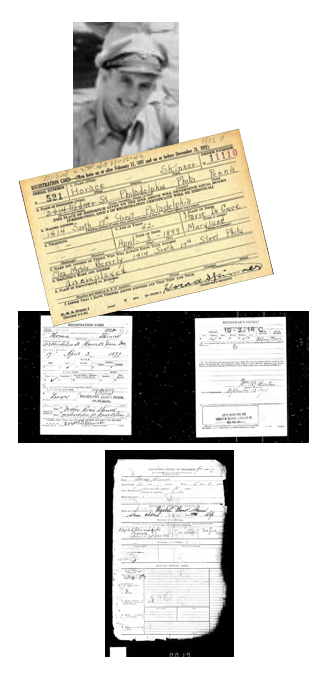1st Lt. Horace Mathew Skinner (POW)
| Discription: | Information: |
|---|---|
| Full Name: | Horace Mathew Skinner |
| Service number: | O-768712 |
| Rank: | 1nd Lieutenant. |
| Function: | Pilot |
| Birth date & Place: | Not Available |
| Woonplaats: | Not Available |
| Age: | Not Available |
| Education: | Not Available |
| Profesion: | Not Available |
| Family: | Not Available |
| Award: | Purple Heart, Air Medal,Prisoner of War Medal, American Campaign Medal,European-African-Middel Eastern Campaign Medal,World War II Victory Medal. Pilot badge. |
| Cemetery: | Not Available |
| Date of death: | Not Available |
| Place of Death: | Not Available |
| Mission data: | Date: 10 January 1945 Mission: 241 Serialnumber: 43-38668 Callsign: BI-T Type: B17-G Date: 10 January 1945 Destination/Mission: Bombing Bridges Cologne afterwards inflight mission changed to bombing bridges Neuss Mission: Bombing bridges. MACR: 11580 |
| Status: | POW (Stalag Luft 3 near Sagan) |


Horace M. Skinner was a First Lieutenant in the Army during World War II. Horace was captured by the Nazis while serving in Germany, and was sent to Stalag Luft 3 near Sagan, Germany where 6,667 other American POWs were held.
Horace's capture was first reported to the International Committee of the Red Cross on January 10, 1945, and the last report was made on June 21, 1945.
Based on these two reports, Horace was imprisoned for at least 162 days (~6 months), one of the shorter durations of captivity recorded, the average being 363 days. Ultimately, Horace was returned to military control, liberated or repatriated.
Stalag Luft III
Sagan, Poland
(Officers)
Location: In a pine woods area at Sagan, Poland about 168 km southeast of Berlin
Opened: East Compound (British) first occupied 21 March 1942; Center Compound 11 April 1942 - first with British sergeants and later in 1942 with Americans; North Compound (British) 29 March 1943; South Compound (Americans) September 1943; West Compound (Americans) July 1944
POW Strength: Camp held over 11,000 Allied Officer airmen when it was evacuated in January 1945. American strength was 6,844 - the largest American officers' camp in Germany.
Camp Description: The camp had six compounds - Three used for American officers (South, Center and West) and three for R.A.F. Officers (including East & North). Each compound had fifteen one story wooden hutments to house prisoners. Barrack rooms were about 10 x 12 feet. The fifteen men in each room slept in five triple-decked bunks. In one corner was a wood or charcoal burning stove. A high wire fence surrounded the buildings. A few feet inside the fence was a low strand of wire - the warning wire. Guards were permitted to shoot any prisoner crossing the warning wire. Guard towers, equipped with powerful searchlights were placed at strategic locations along the fences. Armed guards with police dogs patrolled the interior and exterior perimeter of the camp.
Escape attempts: Escape attempts were started soon after Stalag 3 was established and reached a scale that was hardly reached by any of the other German POW camps. Numerous tunnels were started in the East and Center compounds and eventually in the North (British) and South (American) compounds. Most were soon discovered by the Germans. Almost everyone in all compounds were involved in one way or another in escape attempts. The major escape took place in the North (British) compound on 24 March 1944. It became known as "The Great Escape." A tunnel 336 feet in length, 30 feet below ground level, was constructed. Eighty prisoners made their way out and only three made it back to Great Britain. The rest were recaptured. Fifty of the escapees were executed by Gestapo firing squads.
Stalag 3 Sagan Evacuation: Russian troops were approaching Sagan, Poland. At 11:00 PM on 27 January 1945 Germans marched the POWs out of Stalag 3 with Spremberg for their destination. The exodus was harrowing to POWs of all compounds, especially to those of the South Compound who made the 55 kilometers from Sagan to Muskau in 27 hours with only 4 hours sleep. At Muskau they were given a 30 hour delay for recuperation and then marched another 25 km to Spremberg. On 31 January the South Compound men plus 200 men from the West Compound went to Stalag 7A at Moosburg in rail "forty-and eight" boxcars packed 50 men and 1 guard in each boxcar. The trip took two days and two nights. On 7 February the men from the Center Compound joined them. The North Compound fell in with the West Compound at Spremberg and on 2 February entrained for Stalag 13D at Nurnberg, which they reached after a two day trip.
On April 13, 1945, after an approximate three month stay, the Americans were told that they must evacuate Stalag 13D and march to Stalag 7A at Moosburg. The main body reached Stalag 7A on 20 April 1945. Many POWs dropped out of the march en route to Moosburg and the German guards made no serious attempt to stop them. The POWs were liberated by General Patton's 14th Armored Division on April 29th.
Stalag Luft III - South Compound Ledgers: Maintained by 360th BS/303rd BG(H) Bombardier 2Lt Ewell Ross McCright, MIA on his 3rd combat mission, 23 January 1943 in B-17F #41-24567 Beats Me (360BS) PU-J, 1Lt Joseph E. Haas Crew (7 KIA 3 POW). After capture Lt. McCright was placed in Stalag 3 - South Compound and became very despondent.. The American Security head of the South Compound assigned McCright the task of maintaining records of all American POWs in the camp and of each new arrival. The job proved lifesaving to McCright as it kept his mind and hands busy. The detailed ledgers, ultimately containing names of over 2,100, including thirty 303rd BG(H) crewmen, were hidden from the Germans and would have resulted in his execution if they had been discovered. They were discovered on one occasion and he pointed to the ledger title page which stated that the records contained the names and addresses of dead flying comrades. The discovering guard did not look further into the ledgers but returned them courteously and respectfully to McCright. Later, another search party discovered the ledgers but were returned for a package of American cigarettes. McCright presented the four volume set of ledgers to American Authorities after his liberation. They were stamped "Top Secret" and were eventually flown out of Germany. They proved helpful to the War Department post war searches for casualty records and veterans proof of injuries. Lt McCright obtained his ledgers after the war and after his death on 24 April 1990 they were forwarded to Arnold A. Wright in his hometown of Benton, Arkansas. Mr Wright published the ledgers in a limited edition 1993 book "Behind the Wire, Stalag Luft III, South Compound."
In October 2004 Lt McCright's unselfish efforts were rewarded with the Legion of Merit medal. It was presented to his sister, Marie Hall, by Major General Lewis E. Lyle (retired) at a ceremony in Benton, Arkansas. More information is avaible in the February 2005 Hell's Angels Newsletter.